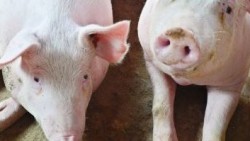Monitoring Antibiotic Resistance
Antibiotic resistance is globally a growing problem which affects both humans and animals. Tackling it is therefore a high priority for organisations such as the World Health Organization (WHO), the Food and Agricultural Organization (FAO) and the World Organisation for Animal Health (WAO/OIE). European collaboration For their part of the EFFORT project, Dik Mevius and his team at Wageningen Bioveterinary Research (WBVR) coordinated the collection of samples from various animal sources (including chickens, pigs, veal calves, turkeys, wild boar, fish, companion animals and meat) in nine countries, in close collaboration with the Institute for Risk Assessment Sciences (IRAS) at Utrecht University. They also collected data on farm practices, and how farms are managed and make use of antibiotics. This research provides important insight into country, animal sector and farm factors that affect antibiotic resistance levels. And that brings us closer to answering the question: how can we control antibiotic resistance? Resistant intestinal tract bacteria related to antibiotic usage The first results that were published were on intestinal tract bacteria (https://www.wur.nl/en/newsarticle/Resistant-bacteria-in-intestinal-tract-linked-to-antibiotic-usage.htm). The research revealed that the quantity and type of bacterial resistomes present in the intestinal tract varies by animal species and country. This means that further research is needed into the causal factors for each animal species. Higher levels of resistance genes in the resistomes are found in the intestinal tracts of pigs than those of chicks, but at the same time chicks have a greater variety of resistance genes. The results of this research are relevant to humans as well as animals, as humans are exposed to resistomes through the food they eat. New results and publications This is just a snapshot: much more data has been collected and analysed, and results will be shared in future publications. Researchers at Ghent University in Belgium have carried out a detailed analysis of antibiotic usage and how it differs by animal species and country. This data is being mapped against the prevalence of E. coli bacteria resistance for each species and country. IRAS is researching how specific farm practices can affect the variance in resistance. Results will also be published on people employed in the food supply chain (such as abattoir workers). This research analysed stool samples of those workers to identify their resistomes and compare them to that of the general population. The objective was to determine the effects of occupational exposure related to employment in the industry. The use of technologies based on sequence analysis (metagenomic analysis) and the standardisation of DNA extraction and bioinformatics analysis in this research provide a frame of reference for future research and the monitoring of antibiotic resistance. Limiting usage and preventing disease introduction Within Europe, and specifically the Netherlands, we are fairly advanced in tackling antibiotic resistance. But we still need to be vigilant in guarding against the introduction of antibiotic resistance from different origins and other parts of the world. Preventing the introduction of disease is an important challenge for livestock keepers. It’s therefore also important that the industry limits the use of antibiotics to when it’s really necessary and maintains good standards of hygiene and biosecurity. Results for policymakers In Nov. 2018, the researchers present the results of their work. High-impact speakers including Louise Fresco (food and agriculture expert and President of the Wageningen University & Research Executive Board) and Mark Woolhouse (professor of infectious disease epidemiology at the University of Edinburgh) will share their vision on the development of global agriculture and the impact of responsible antibiotic use. More information on http://www.effort-against-amr.eu/
Keywords
antimicrobial resistance, antimicrobial resistance usage, AMR, AMU, Biosecurity, antimicrobial resistance surveillance, human exposure, economic aspects, metagenomics, exposure assessment, food, safety, microbiol ecology, genome sequencing, resistome, animal welfare, public health, policy changes
Countries
Belgium, Bulgaria, Switzerland, Germany, Denmark, Spain, France, Italy, Netherlands, Poland



